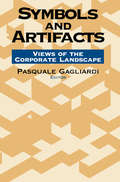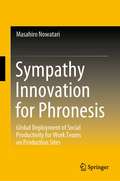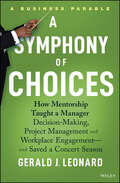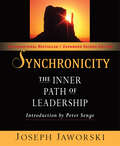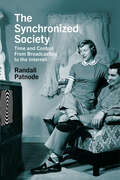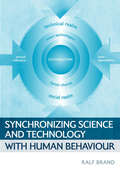- Table View
- List View
SWORDS INTO MARKET SHARES: Technology, Economics, and Security in the New Russia
by Glenn E. SchweitzerWhile researching this book, Glenn Schweitzer met four Moscow physicists who were trying to license Russian technology to western firms for product manufacture. During the worst times, they were reduced to driving taxis to keep things afloat. He asked them, will technological innovation have a discernible impact on the Russian economy in the coming decade? No, was the immediate reply. Are they right?In Swords into Market Shares, Schweitzer examines the roots of such pessimism and the prospects for Russia to prosper from its technology in the post-Soviet world. He explores the different visions of prosperity held by entrepreneurs, technologists, and government officials and goes on to examine the barriers to progress as Russia struggles to build a viable technology industry on its own terms. In accessible language, this book talks about technology's place within Russia's economy and its research and development infrastructure. Schweitzer looks at the impact of the Soviet legacy--central planning, lack of priorities, scant incentives for personal initiative--and the aftermath of the Russian financial meltdown of 1998.He also reviews the experiences of American companies that have invested in Russian technology and examines the results of pressure to reform according to the economic model of the West. Schweitzer goes on to document the problems of economic crime and government corruption, which plague activities designed to generate income in Russia. He discusses the lack of protection for intellectual property and taxation issues that stand in the way of technological innovation. The book looks at the impact of the "brain drain" as Russian experts seek greener pastures--not only the ominous recruitment of Russian biological weapons experts and the acquisition of military technology by "rogue" nations--but also Russia's own program to sell military technology for badly needed funds.Schweitzer's use of case studies and examples puts a human face on these issues. He also discusses Russia's 60 "science cities"--sites of state research centers--with close-ups of three "nuclear cities."Can the technical strengths of the Soviet military complex find a place in civilian Russia? How can this vast country sustain even a minimal standard of living? Swords into Market Shares addresses these and other key questions and explores fundamental policy issues confronting both Russia and the United States as Russia struggles for an economic foothold.
SWOT Analysis I: Looking Outside for Threats and Opportunities
by Harvard Business Review PressCompetitive strategy begins with the iterative assessment of the external environment and the organization's internal capabilities. This process of looking outside as well as inside is known to strategic planners by the acronym "SWOT": Strengths, Weaknesses, Opportunities, and Threats. Using this strategy and Michael Porter's Five Forces framework, this chapter deconstructs the challenge of external analysis.
SWOT Analysis II: Looking Inside for Strengths and Weaknesses
by Harvard Business Review PressCompetitive strategy begins with the iterative assessment of the external environment and the organization's internal capabilities. This process of looking outside as well as inside is known to strategic planners by the acronym "SWOT": Strengths, Weaknesses, Opportunities, and Threats. This chapter addresses three of the most important areas in which a company's internal strengths and weaknesses should be evaluated and presents a nine-step method for conducting your evaluations.
Swvl: Smart Mobility for the Masses
by Esel Cekin Krishna G. Palepu Menna Hassan"The case focuses on strategy and governance issues at SWVL, a tech-enabled mass mobility marketplace. It describes the journey of CEO and Chairman Mostafa Kendil on his journey from founding to the company's listing on Nasdaq. Since its founding in Egypt in 2017, Swvl produced a series of great successes with its innovative solution that promised safe, reliable, and affordable mass commuting trips in markets where such a service was unavailable. In a short time, Swvl was able to raise notable amounts in MENA (Middle East and North Africa) investor funds, expand geographically to neighboring and faraway markets, and become the fastest growing unicorn in the region. Expanding the company's existing regional footprint, Kandil and his team were pursuing their ambition to become the world's number one mass mobility provider. They worked with Queen's Gambit, a SPAC (Special Purpose Acquisition Company), to take the company public on Nasdaq. They established both statutory and advisory boards that would not only guide the company on its growth plans but also showcase its strong compliance agenda-a priority from the outset. Once listed, Swvl would become the second and the youngest MENA-based company to ever go public on Nasdaq. With this, Swvl accepted a challenging responsibility: it would have to position itself among well-established U.S. public companies on one hand and overcome the notorious reputation MENA-based companies had for corporate governance on the other. To emerge successful in global financial markets, Swvl had to ensure that its marketplace design was lean enough to allow the company to grow profitably without compromising customer experience on its rides. Swvl also had to assess its expansion strategy, particularly in terms of how fast and how far it could launch in new markets without mishap.
Symbian: Setting the Mobility Standard
by Thomas R. Eisenmann Fernando F. SuarezSymbian, a joint venture owned by companies who collectively sold a dominant share of the world's cell phones, faced competition from Microsoft in developing the operating system for "smartphones," which integrated mobile communications and computing functions. In 2003, Symbian's challenges included: 1) persuading its owners to adopt Symbian software rather than internally developed solutions; 2) determining whether to cede enterprise markets to Microsoft and focus only on much larger consumer segments; and 3) strengthening relationships with cellular network operators, whom Microsoft had targeted as alliance partners after it was unable to sell software to Symbian's owners.
Symbian, Google & Apple in the Mobile Space (A)
by Fernando F. Suarez Arati Srinivasan Benjamin EdelmanSymbian, maker of a leading mobile smartphone operating system, faces new competition from Google and Apple. Symbian evaluates changes to its software and its relationships with distributors in order to meet these competitors.
Symbiosis of Government and Market: The Private, the Public and Bureaucracy
by Sadao Tamura Minoru TokitaIn this volume, a group of international scholars address issues relating to community wellbeing and the role of politics, law and economics in Europe and Japan in achieving human-centred symbiotic governance. Case-studies and suggestions for reform are presented in the arenas of economy, government administration, management, university governance, health, agriculture, the environment and urban planning.This book will prove a useful tool to those in business research institutes, members of administrative research institutes, NGO's and non-profit organizaions while also providing students of business, Asian studies, politics and law with an insight into possible areas of reform.
A Symbolic Approach to Humanitarian Action: It Takes One to Know One (Contemporary Humanitarian Action and Emergency Management)
by Diego OteguiThis book aims to present an alternative view of humanitarian action. It adds to current conversations and dilemmas within the humanitarian sphere by departing from traditional views that consider humanitarian interventions as a concrete human activity aimed at providing relief to disaster victims. Much differently, it invokes the idea that humanitarian action is also a cognitive process. In this process, both humanitarians and disaster survivors alike, unknowingly, apply historically, societally, and culturally defined symbolic constructions to make sense of post-disaster information and to make decisions. In the specific case of humanitarian workers, these symbolic constructions influence how they understand their post-disaster reality, including how they relate to those they consider to be in pain or distress. This way of looking at humanitarian action builds upon a robust theoretical framework called Institutional Logics, which helps us identify and interpret how individuals make sense of their reality. So it brings the complex world of the individual into a discussion that generally considers the organization as the unit of analysis. Studying humanitarian action through this alternative lens makes it easy to see that objective and verifiable post-disaster information is a necessary but not a sufficient condition to design humanitarian interventions, let alone assess their value and benefits. A Symbolic Approach to Humanitarian Action: It Takes One to Know One aims to bridge the gap between research and practice in humanitarian action by translating academic knowledge into an accessible format that can be used by practitioners to improve their work on the ground.
Symbols and Artifacts: Views of the Corporate Landscape
by Pasquale GagliardiA selection of 18 papers from an international conference in Milan, June 1987, organized by the Standing Conference on Organizational Symbolism. Details how corporate artifacts are invested with meaning, are related to control, and can be used as cultural indicators in research. Among the topics are office design, housing modifications, computer systems, and the space shuttle. Fairly devoid of specialist jargon.
Symbols of Defeat in the Construction of National Identity
by Steven J. MockIf nationalism is the assertion of legitimacy for a nation and its effectiveness as a political entity, why do many nations emphasize images of their own defeat in understanding their history? Using Israel, Serbia, France, Greece, and Ghana as examples, the author argues that this phenomenon exposes the ambivalence that lurks behind the passions nationalism evokes. Symbols of defeat glorify a nation's ancient past, while reenacting the destruction of that past as a necessary step in constructing a functioning modern society. As a result, these symbols often assume a foundational role in national mythology. Threats to such symbols are perceived as threats to the nation itself and consequently are met with desperation difficult for outsiders to understand.
Symmetallism: An Alternative to Orthodox Bimetallism (Routledge Library Editions: The Gold Standard #1)
by Barthold A. ButenschønOriginally published in 1936, this book discusses the post-War reconstruction of the monetary system. It examines the American use of silver and changes to China's currency system and asks whether a combination of gold and silver would not be a better solution than a pure Gold Standard. The book discusses to what extent it is possible to unite the advantages of an orthodox metallic standard with the greater elasticity which was required. Using geometry, the author gives a more complete picture of the relationships involved in Symmetallism and a theoretical account of the symmetallic Bullion Standard.
Symmetry and Economic Invariance
by Ryuzo Sato Rama V. RamachandranSymmetry and Economic Invariance (second enhanced edition) explores how the symmetry and invariance of economic models can provide insights into their properties. Although the professional economist of today is adept at many of the mathematical techniques used in static and dynamic optimization models, group theory is still not among his or her repertoire of tools. The authors aim to show that group theoretic methods form a natural extension of the techniques commonly used in economics and that they can be easily mastered. Part I provides an introduction that minimizes prerequisites including prior knowledge of group theory. Part II discusses recent developments in the field.
The Sympathetic State: Disaster Relief and the Origins of the American Welfare State
by Michele Landis DauberEven as unemployment rates soared during the Great Depression, FDR's relief and social security programs faced attacks in Congress and the courts on the legitimacy of federal aid to the growing population of poor. In response, New Dealers pointed to a long tradition--dating back to 1790 and now largely forgotten--of federal aid to victims of disaster. In The Sympathetic State, Michele Landis Dauber recovers this crucial aspect of American history, tracing the roots of the modern American welfare state beyond the New Deal and the Progressive Era back to the earliest days of the republic when relief was forthcoming for the victims of wars, fires, floods, hurricanes, and earthquakes. Drawing on a variety of materials, including newspapers, legal briefs, political speeches, the art and literature of the time, and letters from thousands of ordinary Americans, Dauber shows that while this long history of government disaster relief has faded from our memory today, it was extremely well known to advocates for an expanded role for the national government in the 1930s, including the Social Security Act. Making this connection required framing the Great Depression as a disaster afflicting citizens though no fault of their own. Dauber argues that the disaster paradigm, though successful in defending the New Deal, would ultimately come back to haunt advocates for social welfare. By not making a more radical case for relief, proponents of the New Deal helped create the weak, uniquely American welfare state we have today--one torn between the desire to come to the aid of those suffering and the deeply rooted suspicion that those in need are responsible for their own deprivation. Contrary to conventional thought, the history of federal disaster relief is one of remarkable consistency, despite significant political and ideological change. Dauber's pathbreaking and highly readable book uncovers the historical origins of the modern American welfare state.
Sympathy Innovation for Phronesis: Global Deployment of Social Productivity for Work Teams on Production Sites
by Masahiro NowatariThis book explores social productivity in work teams on production sites, with an eye toward human welfare. It focuses especially on "sympathy management" by the use of multivariate analysis in a worldwide social survey. Manufacturing production sites have many work teams, and their activities support productivity. Productivity, however, is evaluated only by the production system. Therefore, the social system's sympathy evaluation as teamwork in the work team is completely disregarded by management activity. Management recognizes this social system and must upgrade teamwork as a social system from tacit to explicit knowledge as an appraisal system. Thus, this new paradigm significantly contributes to industrial society beyond conventional management. The work team's social system functions in a production system and affects team productivity. Therefore, it must take a bird's-eye view of social productivity as an overall strategy. Social productivity has two appraisal criteria, the social system's sympathy and the production system's productivity. Increasing explicit knowledge of sympathy as teamwork requires the perspective of human-social science. Social productivity has been verified through global deployment by social research and case studies and contributes to humankind's welfare on sustainable development goals and ISO56000, an innovation management system. Social productivity can also decrease opportunity loss based on ignoring the social system of the work team.
A Symphony of Choices: How Mentorship Taught a Manager Decision-Making, Project Management and Workplace Engagement -- and Saved a Concert Season
by Gerald J. LeonardLearn how to make decisions in the face of increasingly complex and multifaceted challenges In A Symphony of Choices: How Mentorship Taught a Manager Decision-Making, Project Management and Workplace Engagement -- and Saved a Concert Season, workplace culture and strategy expert Gerald Leonard delivers a fascinating narrative following one Jerry Hall, the new Symphony Orchestra manager at a prestigious symphony concerned about the challenging plans for an upcoming season. In the book, you’ll watch Jerry connect with a former college professor and learn the skills necessary to successfully manage his way through these unprecedented times in his business and personal life. Does he have all skills necessary for effective decision-making and managing a major symphony’s portfolio of projects? Will his fear of succumbing to daunting challenges prevent him from succeeding? The author answers these questions, and more. You’ll also find: Hands-on strategies for decision-making and management you can implement today at your organization Methods for navigating an increasingly complex and interconnected environment Ways to apply subject-matter knowledge to your management even in the face of extraordinary personal challengesA necessary and hands-on resource for directors, managers, executives, and other business leaders, A Symphony of Choices will also earn a place on the bookshelves of practicing and aspiring leaders in athletic, academic, military, and other environments.
Synbio and Human Health
by Iñigo Miguel Beriain Carlos María Romeo CasabonaSince 2010, the Inter-university chair in law and the Human Genome has been involved in an EU 7th Framework Programme funded Project called Sybhel, leading work package 5. The aim of this work package was to face the issues related to synthetic biology and intellectual property rights. In these years, the Chair organized two international workshops devoted to this topic, collecting a number of high level unpublished papers redacted by some of the most prominent experts in this field worldwide, including Stephen Maurer, Joachim Henkel, Ingrid Schneider, etc. We consider that it would be extremely interesting to have them all gathered in a unique contributed volume, which would be the first book exclusively dedicated to analyze the implications that Synbio may involve in what refers to the currently existing intellectual property rights system.
Sync or Swim: A Fable About Workplace Communication and Coming Together in a Crisis
by Gary Chapman Paul White Harold MyraWorking with a discouraged, disorganized, cynical team? Learn how to turn it around.Sync or Swim is a small tale with enormous insight on ways you can empower, engage, and energize employees or volunteers facing discouragement or cynicism. Sam, the new CEO, was ready to hit the ground running. But his team members—and Mother Nature—had other plans.An ambitious yet naïve sheepdog is called upon to lead Monarch Enterprises, a troubled organization on a beautiful isle. Confronted with broken systems and challenging personality types, Sam must learn how to marshal his team before the imminent storm washes everything away. Along the way, he gleans valuable lessons from an unlikely mentor: a wise, old puffin. This delightful, quick read will: Teach you communication techniques that enhance teamwork and productivityBring to life the principles used by hundreds of successful organizationsProvide relevant, practical insights based on real-world experiencesStimulate lively and positive interaction (discussion guide included)Based on the principles successfully used by major corporations, health organizations, over 250 colleges and universities, government agencies, churches, and non-profits
Sync or Swim: A Fable About Workplace Communication and Coming Together in a Crisis
by Gary Chapman Paul White Harold MyraWorking with a discouraged, disorganized, cynical team? Learn how to turn it around.Sync or Swim is a small tale with enormous insight on ways you can empower, engage, and energize employees or volunteers facing discouragement or cynicism. Sam, the new CEO, was ready to hit the ground running. But his team members—and Mother Nature—had other plans.An ambitious yet naïve sheepdog is called upon to lead Monarch Enterprises, a troubled organization on a beautiful isle. Confronted with broken systems and challenging personality types, Sam must learn how to marshal his team before the imminent storm washes everything away. Along the way, he gleans valuable lessons from an unlikely mentor: a wise, old puffin. This delightful, quick read will: Teach you communication techniques that enhance teamwork and productivityBring to life the principles used by hundreds of successful organizationsProvide relevant, practical insights based on real-world experiencesStimulate lively and positive interaction (discussion guide included)Based on the principles successfully used by major corporations, health organizations, over 250 colleges and universities, government agencies, churches, and non-profits
Synchronicity: The Inner Path of Leadership
by Joseph JaworskiSynchronicity is an inspirational guide to developing the most essential leadership capacity for our time: how we can collectively shape our future.
Synchronicity: The Inner Path of Leadership (Bk Business Ser.)
by Joseph Jaworski Peter M SengeWe've all had those perfect moments when events that could never be predicted, let alone controlled, remarkably seem to guide us along our path. Carl Jung called this phenomena "synchronicity" - "a collaboration between persons and events that seems to enlist the cooperation of fate." In this book, Joseph Jaworski argues that the right state of mind will make you the kind of person who can enlist the cooperation of fate and take advantage of synchronicity, creating the conditions for "predictable miracles." If you are tired of being the victim of circumstances, this book will teach you to be the kind of person who creates your own circumstances. Jaworski shares the story of his own escape from an inauthentic life and his journey into a world filled with possibility. He maps out the inner path of leadership for those who feel the call to achieve their full potential, using his own life story to teach readers a greater truth. He examines the fundamental shifts of mind that free us to seek out the power of synchronicity. After reading this book, you will discover your own power to help those realities unfold. You will learn to "listen" to realities that want to emerge in this world and acquire the courage to help them be born. "Synchronicity illustrates that leadership is about the release of human possibilities, about enabling others to break free of limits - created organizationally or self-imposed. Although this book describes the author's personal journey, it contains profound messages about organizational learning and effectiveness." - Scientific American
Synchronisieren ist das Neue Selling: Wie Vertrieb, Marketing und Service aus einem Guss verkaufen
by Matthias Huckemann Stephanie MeyDieses Buch liefert in 7 Schritten ein schlüssiges Konzept, wie B2B-Unternehmen ihre Kunden während der Customer Journey hinweg aus einem Guss bedienen können. B2B-Kunden erwarten heute synchrone und abgestimmte Informationen entlang ihrer Buying Journey über alle Touchpoints. Für den Anbieter heißt das: Kunden konsistent beraten, Orientierung geben und über alle Berührungspunkte im Unternehmen hinweg diese abgestimmt und kundenzentriert betreuen.Der Weg zu einer synchronen und kundenzentrierten Marktbearbeitung – funktionsübergreifend in Vertrieb, Marketing und Service realisiert – hat für alle involvierten Akteure massive Veränderungen zur Folge. Gefordert ist ein neues Verständnis für Aufgaben, Rollen und das Selbstbild. Neben der Strategie und dem konkreten Umsetzungsplan haben die Autoren insbesondere die Sicht der Mitarbeiter mit ihren Bedenken und Ängsten im Blick. Nur gemeinsam mit den Mitarbeitern wird dieses Veränderungsmanagement gelingen. Dieses Buch zeigt, wie es geht.Aus dem InhaltDie größten Herausforderungen in B2B-Vertrieb, -Marketing und -ServiceDie 7 Hebel, um erfolgreiche Marktbearbeitungs-Teams zu bilden: Buying und Selling-Journey synchronisieren, die neue Organisation der Teams in einer Kundenzentrierten Marktbearbeitung; Planung, Reporting, Anforderungsprofile, KPIs, Entlohnungssysteme justieren; der Beitrag des Marketings; die neue Rolle der Führungskräfte; wie das Team zusammenwächstMit ausführlichem Fallbespiel eines mittelständischen Familienunternehmens
Synchronized Factories
by Juan S. BlydeThe objective of this report is to examine the extent to which countries in Latin America and the Caribbean participate in global value chains and what are the drivers of such participation. Production processes have been increasingly fragmented worldwide. For example, the production of the Boeing 787 Dreamliner involves 43 suppliers located in 135 locations around the globe. There are many examples like the Dreamliner, from the 451 parts that go into the iPod to the less technologically intensive but still widespread multi-country production of a Barbie doll. All this reflects significant changes in the way world production is being reorganized across national borders. That is, for many goods, production has become a multi-country process in which different stages are carried out in specialized plants in different parts of the world. Countries which specialize in different stages of the production process are thus linked by these global value chains. For developing countries, a clear opportunity from the continuous international fragmentation of production arises in the form of participating in activities that were virtually not opened to them in the past. Therefore, the international fragmentation of production provides opportunities for trade diversification, an issue that can be of particular importance for Latin America and the Caribbean as the region's export base is in general highly concentrated in a few industries and particularly biased towards natural-resource intensive sectors. The aim is to identify whether there is policy space for implementing strategies that allow countries to improve their position in regional and global value chains.
The Synchronized Society: Time and Control From Broadcasting to the Internet
by Randall PatnodeThe Synchronized Society traces the history of the synchronous broadcast experience of the twentieth century and the transition to the asynchronous media that dominate today. Broadcasting grew out of the latent desire by nineteenth-century industrialists, political thinkers, and social reformers to tame an unruly society by controlling how people used their time. The idea manifested itself in the form of the broadcast schedule, a managed flow of information and entertainment that required audiences to be in a particular place – usually the home – at a particular time and helped to create “water cooler” moments, as audiences reflected on their shared media texts. Audiences began disconnecting from the broadcast schedule at the end of the twentieth century, but promoters of social media and television services still kept audiences under control, replacing the schedule with surveillance of media use. Author Randall Patnode offers compelling new insights into the intermingled roles of broadcasting and industrial/post-industrial work and how Americans spend their time.
Synchronizing Science and Technology with Human Behaviour: The Co-evolution Of Sustainable Infrastructures
by Ralf Brand?A rare achievement, one of the first books to link technological and behavioural change to the sustainability agenda? Charles Landry, author of The Creative City ?Any course interested in sustainable development in practice would benefit from the case studies here? Dr Adrian Smith, SPRU Science and Technology Policy Research Unit, University of Sussex, UK Two disjointed voices can be identified in the prevailing sustainability discourse: one technology-focused, the other favouring behavioural solutions. This new, practical text bridges the gap in a 'co-evolutionary' framework, enabling more sustainable policies and projects to be developed. Arguing that technical and social realms are much more connected than most people concerned with sustainability tend to admit, the author has developed an innovative and integrated strategy that encourages planners, architects and politicians to work with end-users in 'co-designing' technologies and infrastructures that make socially desired behaviours more attractive. Having explained the nature of the problem, the author outlines key concepts and shared characteristics of co-evolutionary projects and anticipates possible criticisms. Through detailed analysis and diverse case studies, the reader is presented with a clear picture of a more holistic approach to planning sustainable cities and regions, which will be invaluable for students and professionals alike. This will be an invaluable textbook and planning tool suitable for students of science and technology studies (STS), regional policy and planning, and practitioners including city and regional planners, policy makers and consultants.
Syncra Systems
by Andrew Mcafee Mona AshiyaSyncra Systems makes Internet-based software that allows supply chain partners to compare disparate forecasts and production plans, to uncover any discrepancies among them, and to address these issues. However, many potential Syncra customers perceive that they will pay for the software that will benefit others, making Syncra's products a questionable investment. Syncra must find effective ways to address this concern during the sales process. In addition, the company must decide how to best position its products for the marketplace, where they can potentially add great value.



